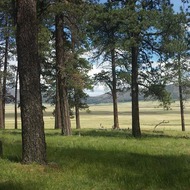Response of uneven-aged in interior Douglas-fir stands to precommercial thinning in central interior, British Columbia
(View Complete Item Description)Proper management of uneven-aged interior Douglas-fir (Pseudotsuga menziesii var. glauca) stands is important for British Columbia’s central and southern interior. These stands constitute one of main components of the operable forest land in these areas, with easy access from main roads and towns. This study focused on the growth of uneven-aged Douglas-fir stands after pre-commercial thinning (spacing), with an impetus to improve upon current management practices. Data were collected from 24 permanent sample plots which were established near Williams Lake, British Columbia in 1989; thinning took place between 1990 and 1991. Three measurements have been made post-treatment: 1993, 1997 and 2004. The plot data were used to analyze different growth responses among three different spacing regimes (standard, 3 m clumped and 5 m clumped spacing) and a control. Analyses were performed at both the stand and tree level. The growth of basal area per ha, quadratic mean dbh, volume per ha and Lorey’s height were used for stand level analyses. At the tree level, dbh, height, basal area and volume were the variables of interest. At the stand level, mortality increased (7.1 to 107.1 stems/ha) and ingrowth decreased (2.4 to 8.6 stems/ha) for the second growth period (1997-2003), compared to the first growth period (5.8 to 107.1 stems/ha and 5.0 to 12.4 stems/ha, respectively). No significant differences in annual growth of quadratic mean dbh, basal area and volume per ha and Lorey’s height were noted between the different spacing regimes and the control. At the individual tree level, the 5 m clumped spacing regime usually had the highest dbh, basal area and volume growth for both growth periods. The one exception was for height growth, when analyzed using mixed-effects modeling, where no significant differences were found. Trees on the other two spacing regimes also had higher growth in dbh, basal area, and volume than trees on the control plots. The positive growth response to the spacing treatments at the single tree level was obtained without a reduction in growth at the stand level. This growth increase will result in the residual trees reaching larger sizes more quickly than they would have with no treatment, leading to improved mule deer winter range habitat and higher timber values.
Material Type: Reading

